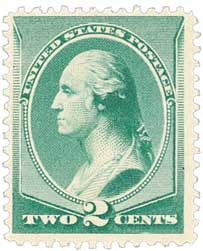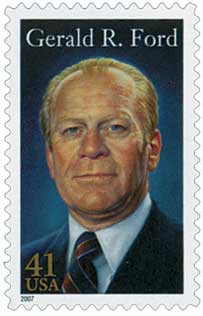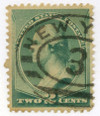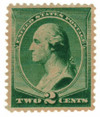
# 213 - 1887 2c Washington, green
Series of 1887 2¢ Washington
Issue Date: September 10, 1887
Quantity issued: 4,542,239,300
Printed by: American Bank Note Company
Method: Flat plate
Watermark: None
Perforation: 12
Color: Green
Old North Church

On April 15, 1723, the first stone was laid for Boston’s Christ Church, more famously known as the Old North Church. It’s home to the oldest church bells in America. It was made famous during Paul Revere’s midnight ride with the signal, “one if by land, two if by sea.”
Plans for the church began in 1722. At the time, King’s Chapel wasn’t large enough to hold all the city’s growing population of Anglicans. In September 1722, people were invited to donate money to help sponsor the building of a new church. The first stone for that church was laid on April 15, 1723 by Reverend Samuel Miles, the minister of King’s Chapel. The church’s official name was Christ Church. It eventually became known as “Old North,” for being the oldest church in the North End.

Though it was still under construction, the church held its first public worship on December 29, 1723, led by Reverend Timothy Cutler. The church’s construction would last 22 years. Its architecture was inspired by that of Sir Christopher Wren. During that time, they received gifts of communion silver, a bible, prayer books, cushions, and vestments from King George II. One of the prayer bibles is known as the “Vinegar Bible” and is one of eight known editions with the misprint “parable of the vinegar” (which is supposed to read “parable of the vineyard”).

The church received its first organ in 1736 and the steeple was added in 1740, with a weathervane designed by Deacon Shem Drowne. In 1745, the church installed a “peal of eight bells” cast in England. These were the first church bells in the colonies. When he was 15 years old, Paul Revere helped found the guild of bell-ringers and signed up to ring them himself.
Twenty-five years later, Revere helped make the church famous. On the night of April 18, 1775, the British were planning to go to Lexington to arrest Samuel Adams and John Hancock for their role in the independence movement. Revere was tasked with riding to Lexington to warn the men. The weekend before his planned ride, Revere spoke with fellow members of the Sons of Liberty, and they arranged a lantern signal using the bell-tower of North Church to warn of the British approach. The signal would be sent by lighting one lantern if they marched by land or two if they rowed “by sea” across the Charles River to Cambridge.

On the evening of April 18, Revere traveled to the North Church to have the patriots stationed there light two lanterns to alert Charlestown that the British would arrive by sea. Revere then set out on his ride. He reached Lexington around midnight and warned Adams and Hancock of the approaching British. Revere then set out to warn the people of Concord, but the British captured him and two other riders. Revere was eventually released and had to walk back to Lexington.

The church was closed for a few years during the Revolution. The original steeple was destroyed in an 1804 hurricane and was rebuilt based on historic drawings in 1806. In 1815, the Salem Street Academy, located on the north side of the church property, hosted the first Sunday school in Boston. That same year, a bust of George Washington was installed in the church, and Marquis de Lafayette would later remark that it was the finest likeness of the president he had ever seen.
Several presidents visited the church over the years – James Monroe in 1817, Theodore Roosevelt in 1912, Franklin D Roosevelt in 1920, and Calvin Coolidge in 1923 (for the church’s 200th anniversary). In 1954, the church’s steeple was toppled by another hurricane. Donations from across the country poured into help build a new one. The church was declared a National Historic Landmark in 1966 and held a re-enactment of the stone laying for the church’s 250th anniversary in 1973.

On April 18, 1975, President Gerald Ford visited the church as part of the Bicentennial. Descendants of Robert Newman (who lit the lanterns for Revere in 1775) lit two lanterns and the president lit a third. The following year, Queen Elizabeth II visited the church and remarked on the lamp lighting, saying the “third lantern [was] dedicated to America’s third century of freedom and to renewed faith in the American ideals. May its light never be dimmed.
The church is still open today, part of the Episcopal Diocese of Massachusetts. It’s also one of 16 stops on Boston’s Freedom Trail.


Series of 1887 2¢ Washington
Issue Date: September 10, 1887
Quantity issued: 4,542,239,300
Printed by: American Bank Note Company
Method: Flat plate
Watermark: None
Perforation: 12
Color: Green
Old North Church

On April 15, 1723, the first stone was laid for Boston’s Christ Church, more famously known as the Old North Church. It’s home to the oldest church bells in America. It was made famous during Paul Revere’s midnight ride with the signal, “one if by land, two if by sea.”
Plans for the church began in 1722. At the time, King’s Chapel wasn’t large enough to hold all the city’s growing population of Anglicans. In September 1722, people were invited to donate money to help sponsor the building of a new church. The first stone for that church was laid on April 15, 1723 by Reverend Samuel Miles, the minister of King’s Chapel. The church’s official name was Christ Church. It eventually became known as “Old North,” for being the oldest church in the North End.

Though it was still under construction, the church held its first public worship on December 29, 1723, led by Reverend Timothy Cutler. The church’s construction would last 22 years. Its architecture was inspired by that of Sir Christopher Wren. During that time, they received gifts of communion silver, a bible, prayer books, cushions, and vestments from King George II. One of the prayer bibles is known as the “Vinegar Bible” and is one of eight known editions with the misprint “parable of the vinegar” (which is supposed to read “parable of the vineyard”).

The church received its first organ in 1736 and the steeple was added in 1740, with a weathervane designed by Deacon Shem Drowne. In 1745, the church installed a “peal of eight bells” cast in England. These were the first church bells in the colonies. When he was 15 years old, Paul Revere helped found the guild of bell-ringers and signed up to ring them himself.
Twenty-five years later, Revere helped make the church famous. On the night of April 18, 1775, the British were planning to go to Lexington to arrest Samuel Adams and John Hancock for their role in the independence movement. Revere was tasked with riding to Lexington to warn the men. The weekend before his planned ride, Revere spoke with fellow members of the Sons of Liberty, and they arranged a lantern signal using the bell-tower of North Church to warn of the British approach. The signal would be sent by lighting one lantern if they marched by land or two if they rowed “by sea” across the Charles River to Cambridge.

On the evening of April 18, Revere traveled to the North Church to have the patriots stationed there light two lanterns to alert Charlestown that the British would arrive by sea. Revere then set out on his ride. He reached Lexington around midnight and warned Adams and Hancock of the approaching British. Revere then set out to warn the people of Concord, but the British captured him and two other riders. Revere was eventually released and had to walk back to Lexington.

The church was closed for a few years during the Revolution. The original steeple was destroyed in an 1804 hurricane and was rebuilt based on historic drawings in 1806. In 1815, the Salem Street Academy, located on the north side of the church property, hosted the first Sunday school in Boston. That same year, a bust of George Washington was installed in the church, and Marquis de Lafayette would later remark that it was the finest likeness of the president he had ever seen.
Several presidents visited the church over the years – James Monroe in 1817, Theodore Roosevelt in 1912, Franklin D Roosevelt in 1920, and Calvin Coolidge in 1923 (for the church’s 200th anniversary). In 1954, the church’s steeple was toppled by another hurricane. Donations from across the country poured into help build a new one. The church was declared a National Historic Landmark in 1966 and held a re-enactment of the stone laying for the church’s 250th anniversary in 1973.

On April 18, 1975, President Gerald Ford visited the church as part of the Bicentennial. Descendants of Robert Newman (who lit the lanterns for Revere in 1775) lit two lanterns and the president lit a third. The following year, Queen Elizabeth II visited the church and remarked on the lamp lighting, saying the “third lantern [was] dedicated to America’s third century of freedom and to renewed faith in the American ideals. May its light never be dimmed.
The church is still open today, part of the Episcopal Diocese of Massachusetts. It’s also one of 16 stops on Boston’s Freedom Trail.
















